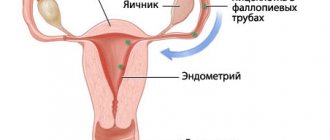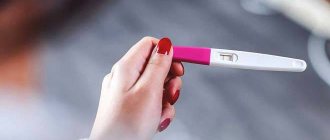Lack of menstruation is one of the first signs of pregnancy. The fact of conception is confirmed by conducting a special test. If this is a desired pregnancy, then the woman is happy and is preparing to become a mother. But what could suddenly starting menstruation mean? This indicates that ovulation has not occurred or something has gone wrong. A repeat test is required. But will the results be reliable if menstruation occurs during this period?
A weak second line on the test - how to understand whether pregnancy has occurred or not?
The first suspicions that conception has occurred arise after the appearance of a delay.
And some women, if this is not their first pregnancy, begin to think long before this moment. To completely dispel doubts, a woman can use a pregnancy test. It is very easy to do: you need to collect urine (preferably morning urine) in a container, immerse the test strip there until the indicated mark, hold for a couple of seconds, and then let the reagent develop. Thus, within 5 minutes the true position of the woman is determined.
Obstetric practice has shown that the final result will be influenced by many external factors. Therefore, a woman often notices a weak second line on a pregnancy test. According to the instructions, during pregnancy it should have a clear silhouette and contrast. A different result may be caused by poor quality of the test itself, non-compliance with the rules of the procedure, or too short a pregnancy with insufficient hCG concentration.
Information about the operation of pregnancy tests helps to understand why the second strip does not color completely. Any test has a reagent that displays the amount of hCG exceeding 25 units. Normally, without pregnancy, the indicator is 0-5 mIU/ml. But as soon as conception occurs, it begins to grow and reaches several thousand.
In the first weeks, the indicator fluctuates between 25 and 156 mIU/ml and the higher the concentration, the brighter the color of the second strip. Therefore, at the time of delay on the first or second day there will be a weak second strip.
How and when can you take a pregnancy test during your period?
The instructions for conducting testing on critical days are no different from the standard situation with the only difference being that if we usually often conduct research in any place convenient for us and at a time convenient for us (at work, in public institutions), then in this situation it is better carry out the procedure in the morning, having first performed thorough intimate hygiene (and to be on the safe side, you can insert a tampon into the vagina to prevent bloody discharge from getting into the tested urine).
First, it's important to understand how a pregnancy test works so you can get the most accurate test result. This hormone may be found in your urine if you are pregnant. Many home pregnancy tests claim to be more than 99% accurate when taken on the first day of the missed period or earlier. You are more likely to get a false negative than a false positive due to a faulty test or hormone levels that are too low to detect.
So, when should you take a pregnancy test? If you test before the first day of your missed period, you may actually get a positive result. But it's also more likely that you might get an inaccurate result. On the other hand, it may show a positive result and not develop into an actual pregnancy due to the frequency of spontaneous miscarriage. They can happen before your period is up and usually won't make you any smarter.
Make sure that the expiration date and integrity of the packaging are not compromised, prepare a sterile container for collecting urine (if you are using test strips), lower the strip strictly to the mark indicated on it (not higher than this level) and follow the time limits specified in the instructions.
Do you have periods during pregnancy?
The menstrual cycle occurs in three stages: follicle maturation, ovulation and the appearance of the corpus luteum. The uterus is covered with the endometrium, which is penetrated by many capillaries and accumulates, under the influence of the hormone progesterone, the nutrients necessary for conception. In the absence of fertilization, the concentration of progesterone decreases, and the endometrium, which grew to attach the fertilized egg, exfoliates, injuring the capillaries. Blood mixed with endometrial particles comes out through the vagina - this is menstruation.
If conception has occurred, then the female body begins to work differently. In the ovaries, eggs stop maturing, the concentration of hormones changes, and in the uterus the processes of growth and exfoliation of the endometrium stop. The fetus uses the mucous membrane as a source of nutrition. Since the endometrium is not destroyed, menstruation does not occur during pregnancy.
It seems quite logical that during menstruation the pregnancy test will be negative - after all, if there is blood, there has been no fertilization. However, experts still cannot confidently talk about the mechanisms of a woman’s body, so different situations are possible. It happens that after a pregnancy test shows 2 lines, a woman begins her period. Why is this happening?
To give the correct answer to the question - does the monthly cycle begin after the test shows a positive result, it is worth understanding the processes occurring in the body of women. The main stage of the menstrual cycle is the process of egg maturation. If the egg remains unfertilized, it leaves the endometrium. This is called the menstrual cycle.
If the egg has been fertilized, then changes occur in the body that prepare the woman for future childbirth. The body spends all assets to preserve the embryo. During pregnancy, there is a sharp increase in the content of the hormone progesterone in the body. It is responsible for enlarging the inner lining of the uterus. Moreover, progesterone prevents contraction of the uterine muscles.
From all of the above, it follows that menstruation and pregnancy are, although interconnected, rare phenomena. However, there are cases when the test shows 2 stripes and the menstrual cycle has begun as planned. What is the reason?
According to scientists, menstruation in the first months of pregnancy is acceptable. More likely, the egg was fertilized in the middle of the cycle, as a result of which the body was not rebuilt. This is explained by the fact that the fertilized egg did not have time to reach the uterus and gain a foothold in it. Typically, the process takes from 5 to 14 days.
Some women are unaware of pregnancy due to the fact that the menstrual cycle follows a schedule. So, what are the main reasons:
- Hormonal imbalance. If the test result showed 2 stripes and menstruation came as planned, then most likely the woman’s body lacks the main female hormone - progesterone. Women note discharge of low intensity. Taking into account the unstable hormonal background of women, menstruation can be observed during the first trimester, involving the second. To eliminate the problem, a course of drugs representing a progesterone analogue is prescribed.
- Presence of 2 eggs. Thanks to this, the maturation of the egg occurs in parallel. However, only one is fertilized while the second leaves the female body.
- Unfavorable location of the egg. If the egg is located in a dangerous place, this will affect the blood circulation process. This kind of violation can lead to egg rejection.
- Frozen pregnancy.
Each of the above reasons can lead to miscarriage, which is accompanied by spotting. To avoid the development of such problems, the woman is prescribed a course of therapy.
Of course, there are other reasons why the menstrual cycle begins with a positive test result. Experts do not classify other causes as dangerous. In this situation, the menstrual cycle begins at a certain point. It is worth noting that the cycle is characterized by different intensity and duration. As for the duration, it can vary within one day or several.
Causes of bleeding during pregnancy
Women are perplexed by the positive test result and the appearance of menstruation at the same time. Among the reasons for this incomprehensible phenomenon are the following:
- A miscarriage or spontaneous abortion has occurred. Discharge during this period resembles menstruation. The difference is that they are abundant and accompanied by severe pain. The test gives a positive result, since the high content of hCG in the urine has not yet had time to decrease after the miscarriage occurred.
- “Colored” pregnancy , in which normal development of the fetus occurs and at the same time regular, albeit small, spotting is observed. Women are unaware of their “interesting” situation and find out about it only when the baby begins to show activity.
Faint second line on the test: what does it look like?
Since a sufficient level of hCG is required to confirm pregnancy, there is no point in taking a test one day after sexual intercourse. Only after 3-4 weeks will the reagent be able to perceive this hormone in the urine.
Each test is divided into two sectors: control and indicator. When enough biomaterial enters the control sector, a bright red stripe appears. This confirms that the test strip is of high quality and has been used correctly.
The role of the indicator is to determine possible pregnancy. When the test was carried out in the morning (during this time the urine is more concentrated), a red stripe will appear during pregnancy, which will be identical to the control. The appearance of a dull line is not proof of pregnancy. Therefore, a woman needs to conduct additional research.
How the test works
Testing is based on determining the content of the hormone human chorionic gonadotropin in the urine, the presence of which is noted in the blood of any person. But in the normal state its quantity is minimal, and during fertilization it begins to double every 2 days.
First, an increased level of the hormone is noted in the blood, and over time, tests show its presence in the urine. The tests are impregnated with a special substance, which upon contact with urine produces a result. Two stripes appear only if the hormone content is high.
Jet tests to detect conception
Reasons for a dim line on the test include:
- Early diagnosis. The manufacturer of the tests recommends testing from the moment of absence of menstruation, when the hCG level is sufficient. However, supersensitive systems are able to detect hCG already 9-12 days after ovulation, but the second strip will not be bright.
- Poor quality of the test system. The device can either be stitched or manufactured with irregularities from the very beginning. The second line on the test will be pale or false negative.
- Misunderstanding of the result. Often there is a situation when a woman wants to be pregnant so much that she looks too closely at the test. If you carefully examine the area with the reagent, you will notice a subtle outline of the second stripe, but it is not indicative and only indicates the place where the real stripe appears. If you don’t look so closely, this ghostly stripe is not visible.
- Delayed ovulation. If the egg was released not in the middle of the cycle, but a week later, then even after the delay, the test will show a weak second line. It happens when the days of the cycle do not correspond to the hCG production schedule.
- Unsuccessful implantation. If the fetus is not firmly attached to the endometrial ball or is rejected, the hCG level will be abnormally low for the existing gestational age. For this reason, the second line will be pale, and if the pregnancy is terminated, the repeat test will be completely negative.
- Neoplasms that produce hormones. Oncology, benign tumors of the liver, uterus, and ovaries are capable of producing hormones of the female reproductive system, which affects the indicators of a pregnancy test. Therefore, a non-pregnant woman may show a weak second line before the delay.
- Ectopic pregnancy. The combination of a delay of more than two weeks and a pale line on the test requires exclusion of ectopic implantation. With this pathology, hCG also increases, but the level will be slightly below normal.
- Eco. Artificial insemination often involves the use of hormonal agents. They significantly affect the pregnancy test reading. Therefore, the first gestational weeks will be accompanied by a pale second stripe.
A situation where a woman has a blurred line on the test coupled with blood discharge from the vagina requires clarification from the doctor. In most cases, a woman experiences arbitrary rejection of a fertilized egg with a genetic defect. A woman may not even be aware of this, but it does not affect her health. If the manipulation is repeated, the test will be negative, and menstruation will proceed as usual.
But sometimes such a symptomatic picture can indicate various complications during pregnancy. So, menstruation can occur with a threatened abortion, detachment of the ovum, or ectopic pregnancy. Such pathologies lower the hCG level, which is why the second strip is weak.
It also happens that the test shows a fuzzy line, but everything is fine with pregnancy. Why then do you have periods? It turns out there are a number of reasons for this:
- Hormonal imbalance - if fertilization occurs late, slight menstruation may occur. This happens when the implantation of the fertilized egg into the endometrium has not yet occurred, and the time for menstruation has arrived.
- The simultaneous fertilization of two eggs is a rare exception, when one fertilized egg is just sent to the uterus, and the second already leaves the body along with menstrual flow. Therefore, it is quite understandable that the test shows a faint line indicating pregnancy, and at the same time menstruation occurs.
- Progesterone deficiency - a lack of progesterone, which ensures the safety of pregnancy, often provokes bleeding. They may appear on days when menstruation was scheduled to occur.
Tests to confirm pregnancy differ in the way they determine hCG levels. The quality of the result, including the period of appearance of the second strip and its saturation, depends on the concentration of this indicator in the urine. To make it easier for you to understand the possible changes in the second strip taking into account the day of the cycle on different test systems, look at the continued photos with a description.
The first photo shows that from days 26 to 29 of the cycle a very faint second stripe is noticeable. From the second day of the delay it becomes quite clear. To determine pregnancy, primitive test strips were used here.
Below you can see the dynamics of the appearance of the second band on digital test systems. At the most recent test, pregnancy is confirmed by analyzing the hCG level, which corresponds to 2-3 gestational weeks.
But this is a false positive test. On the 4th day of the delay, the test showed a weak second line, but it soon stopped appearing and on the 6th day the pregnancy was not confirmed.
Now you know what the second pale stripe means. And if such a situation arises, be sure to consult a gynecologist, undergo ultrasound diagnostics or donate blood to determine hCG. Then you will know for sure whether you are pregnant or not.
For every woman, two stripes give the opportunity to experience not just a period, but a whole small journey in which only she communicates with the baby. The whole family eagerly and tremblingly awaits the appearance of the main member of the family. Parents can only wait for the baby, and in their free time fantasize about what the baby will be like.
As for the process of the emergence of a new life, it is peculiar, unique and has its own development scenario. Some mothers find out about pregnancy by taking a test, while others focus on the delay and changes occurring in the body. Due to the fact that the female body is such an amazing and unpredictable system, only a specialist can determine pregnancy.
The principle of operation of this test is very simple. The urine of a pregnant woman contains the hormone hCG (human chorionic gonadotropin), which occurs as a result of pregnancy to form the future placenta. On days 6-8 of conception, chorion produced appears only in small quantities, but this is enough for the test to determine the presence of new life.
What does a pregnancy test consist of?
In addition, the test system has two zones: diagnostic and control. The diagnostic zone determines the result of contact between antibodies and hCG. At conception, a faint pinkish or red stripe appears here. In higher quality tests, hCG is checked twice, and if there is definitely a pregnancy, then an additional strip will appear in the control zone.
All quick methods for determining pregnancy can be divided into three main groups:
- pregnancy strip test;
- tablet tests;
- inkjet tests.
All three methods have different devices for determining conception, but the principle of operation and analysis are the same.
The simplest and most accessible means of diagnosing conception. It is a strip, often made of paper impregnated with a special reagent. More expensive tests are tissue based, but the reagent for detecting hCG remains unchanged.
Working with the test strip is quite simple. You need to immerse it in urine for 5-10 seconds, and within 5 minutes the result will be ready.
It is worth remembering that in the first days of a missed period, the test’s accuracy is about 90%, and after 8-10 days such a simple paper pregnancy test can give a guarantee of 95-100%.
All testing conditions must be followed correctly. Many girls make mistakes even after thoroughly reading the instructions.
Basic requirements for performing the strip test:
- The urine that will be used in the test should be more concentrated, so it is best to use morning urine.
- The jar in which urine is collected must be clean. It is best to use a container made of glass or plastic.
- You should not wait longer than the specified time.
If the pregnancy test shows two lines, then you are pregnant. One line – conception did not occur.
So, the advantages of this test:
- There is a huge selection in every pharmacy, and recently test strips are also sold in supermarkets. In a word, finding it will not be difficult. Rather, you can get confused from the huge selection of manufacturers.
- Low cost. Even the most expensive tests cost very little.
However, such testing also has disadvantages:
- the test requires collecting urine in a container, which may cause some inconvenience;
- The sensitivity of the test strip is somewhat limited;
- paper cannot always withstand the required concentration, so the cheapest tests often give an erroneous answer.
In such cases, it is best to buy a package of pregnancy tests in a set of 2 or more pieces. In order for the test to show the most accurate result, it is recommended to buy several tests from different manufacturers. Repeated analysis should be done no earlier than after 2 days.
Jet tests are the most modern way to quickly test pregnancy. It is generally accepted that they give the most accurate results.
The peculiarity of such tests is that, in addition to the reagent with antibodies, they also contain a certain layer of special blue particles that very closely approach the hCG hormone. Another feature is the instant result. In just a minute, the jet test will give the most accurate answer regarding conception.
- the test can be used under any conditions, at any time of the day;
- reliable results from the first day of delay.
Among the disadvantages, we can only note the highest cost among all analyzers.
The answer depends on your financial wishes and the conditions in which the test needs to be performed. On the one hand, the inkjet test will give the most accurate result, and on the other hand, several test strips from different manufacturers can also honestly answer your main question. However, if you are in a hurry to determine pregnancy and want to know for sure already in the first days of the delay, then an inkjet or tablet is best.
What result will a pregnancy test show if taken during menstruation?
Since premenstrual syndrome and pregnancy in the earliest stages manifest themselves with almost identical symptoms, women very often confuse these two different conditions. Therefore, in most cases, the result of the study against the background of critical days will be a negative test during menstruation. And this result should be accepted calmly. However, if you have every reason to believe that you are pregnant, then a few days later (preferably a week after the end of menstruation) testing should be repeated to exclude an unreliable result (the hCG level by the first day of menstruation may not yet be high enough or the test you use may turn out to be insufficiently sensitive - and it will not show pregnancy).
Is it true that the best time to check is in the morning?
It is always best to follow the manufacturer's instructions that come with the test, as the procedure can change and affect your result if not done properly.
Once you remove the test from the bag, do not touch the absorbent pad. There are usually two ways to do the test, in the middle or in the cup. If you prefer to test mid-stream, all you need to do is hold the test almost vertically and pass it through a weak stream of urine, making sure you avoid getting any water or urine on the device before starting the test. A positive pregnancy test during menstruation should be a reason for reflection, because in this case there may be several options:
- Bloody discharge appeared as a result of a miscarriage that had begun or occurred, which the woman would not have known about if she had not undergone testing (in this case, periods are usually heavy and painful, but not necessarily). Since hCG has already begun to increase after implantation of the fertilized egg, its level even with the onset of a miscarriage may remain high enough for the test to show a positive result.
- The resulting pregnancy develops normally, but in the days when you had menstruation before conception, spotting appears. They are not as abundant as usual, but the situation can repeat several cycles in a row against the background of a normally developing pregnancy (which is called “colored” or “latent”). This doesn’t happen often, but it’s still not an exception.
- There was no pregnancy, but there is some gynecological disease, which is why the test showed a false positive result. In particular, some types of hormonal tumors are capable of producing hCG (as after conception).
Therefore, if a pregnancy test during menstruation shows a positive result, then it is necessary to repeat the test a week later (at least one more time), and if it is confirmed, contact a gynecologist urgently. The doctor will be able to clarify the situation: confirm the pregnancy and refer you for an ultrasound; detect an incipient miscarriage and hospitalize; or suspect pathology by prescribing the necessary examinations.
If you prefer to use the cup method, urinate into a clean, dry container and dip an absorbent pad into the urine for 3-5 seconds. You do not completely submerge the absorbent pad, 1cm is sufficient. If you are taking antibiotics, birth control pills or painkillers, this should not affect the test result. Talk to your pharmacist or caregiver for more information. Clomid does not produce false positives for pregnancy tests, but it may produce false positives for ovulation tests.
What does a positive pregnancy test look like?
A positive pregnancy test will show the reference line that was present before you took the test, and a second line will appear after the urine passes through the window. Some tests now have two separate windows where strings must be displayed in each window. Other tests are designed to have a cross to indicate a pregnancy test, so they may vary - just read the package to know what to look for.
We wish you that everything ends well in any case!
Especially for
—
Elena Semenova
Pale second line on the test: what does it mean?
- Attachment of the fertilized egg to the uterine mucosa. It penetrates the endometrium, causing capillaries to rupture. In this case, very little blood comes out, just a few drops. There is no threat to the development of the fetus - this is physiological bleeding, which is a variant of the norm.
- Untimely implantation of the egg. Fertilization occurred, but the egg did not have time to leave the fallopian tube. The body “does not know” about conception, since the production of hormones intended to preserve the fetus has not yet begun. The embryo will be fixed after menstruation on the renewed layer of the endometrium. This happens in women who have a short 21-day menstrual cycle. In such a situation, your period should appear only once. If discharge appears next month, this is a reason to make an appointment with a gynecologist.
- Double ovulation. In the ovary, two eggs mature simultaneously or with a difference of a couple of days, one of which is fertilized by a sperm, and the second dies and is released with menstruation, which in this case occurs without delay. The production of hormones, which allows two germ cells to mature at once, is observed in 10% of women.
- "Colored" pregnancy. This is a rare phenomenon, the nature of which has not been studied. Discharge appears monthly, at the same time as usual, but against its background, normal fetal development occurs. The only difference from normal menstruation is the small volume of blood. Bleeding stops after 12 weeks, but sometimes occurs monthly until delivery.
- Hormonal imbalance. If there is a lack of progesterone, the uterus will try to reject the embryo. The same can happen if a woman has an excess amount of male hormones in her body.
- Fixation of the fertilized egg in an inconvenient place. The phenomenon is common among women suffering from fibroids or endometriosis.
- Spontaneous abortion. If a woman becomes pregnant but has her period before 12 weeks, this may indicate a miscarriage. Additional signs by which pregnancy failure can be determined are pain in the lower abdomen.
- The location of the embryo outside the uterus. The test shows a positive result, but the woman begins to spot and then bleed. When the fallopian tube ruptures, severe abdominal pain, weakness, and blood pressure drop occur.
- Placenta previa. Blood loss is possible if it is located too low. This happens to women after numerous abortions or previous births that ended in caesarean section.
All pharmacy types of pregnancy tests, regardless of price and method of use, work the same way - they are aimed at detecting the level of the hCG hormone in the urine. It is present in the body of every person, but in minimal quantities. After fertilization and the beginning of the formation of the placental barrier, its level steadily increases: first it enters the blood, and then into the urine.
The applicator contains a reagent that reacts with hCG. With its increased concentration in the urine, a second line will appear on the strip.
Experts say that periods do not affect the outcome of testing. It will show the correct result, since discharge does not change the concentration of hCG, so the answer is clear - you can do the test during menstruation.
The advisability of the test during menstruation
Even if the first data from a test during menstruation are negative and the presence of hCG is not confirmed, doctors definitely recommend repeat testing. The expediency of the secondary procedure is explained by the fact that after fertilization the amount of the hormone is very small and is not detected in the urine. After a few days, the level of glycoprotein will increase. This will show the test and help dispel doubts. For greater confidence, the procedure is carried out 2 times after several days.
The presence of bloody discharge does not matter at all and does not affect the outcome. If pregnancy occurs, the test will be positive. We cannot deny the fact that taking a pregnancy test during menstruation is advisable.
Testing is based on determining the content of the hormone human chorionic gonodotropin in the urine. In the normal state, its quantity is minimal, but during fertilization it doubles every 2 days.
At first, increased levels of the hormone are noted in the blood, and over time, tests show its presence in the urine. The tests are impregnated with a special substance, which upon contact produces a result. Two stripes appear only if the hormone levels are high.
Features of the procedure
Each strip strip purchased at a pharmacy is equipped with instructions for proper testing. However, if there is a delay, the check can be carried out anywhere, even in a public toilet, but in case of bleeding, more comfortable conditions are needed. Features of performing the procedure during menstruation:
- in the evening you need to limit your fluid intake;
- the test is performed in the morning using the first portion of urine;
- before collecting biomaterial, you need to wash it with water, and then put a hygienic tampon so that the blood does not drain into the urine;
- It is better to carry out the test at home, where the woman can sit comfortably.
There is information in the instructions about the depth of immersion of the strip strip, the time it remains in the liquid, the volume of the container and other rules. The strip cannot be reused if it is a one-time use and gives a negative result.
A pregnancy test during menstruation is advisable if taken from the third day of bleeding. If conception has occurred and the blood is not menstrual, then by this time the concentration of hCG will be high, and the hormone will react with the test reagent.
Probability of errors
Testing is not a 100% guarantee of conception. The possibility of error always exists and should not be ignored. False results are acceptable in the following cases:
- The amount of hCG in the urine is not determined due to the fact that conception occurred so recently.
- If there is an ectopic pregnancy, the 2nd line will be barely noticeable. The procedure should be repeated later. It is recommended to visit a doctor.
- The test is expired and therefore the results are skewed.
- The device you are using is damaged.
Probability of error
A woman can receive a false negative answer in the following situations:
- the procedure was carried out in violation of the instructions (insufficient volume of urine was used, the container for collecting it was not sterile, etc.);
- there are disruptions in the functioning of the endocrine system;
- the integrity of the test is compromised;
- short period of pregnancy, when the concentration of the hCG hormone in urine is too low for it to react with the strip reagent;
- frozen pregnancy or placement of the embryo outside the uterus.
A false positive answer will result for the following reasons:
- the woman is taking hormonal medications;
- recently had a miscarriage or abortion;
- ovarian dysfunction;
- there are diseases of the reproductive system that provoke the production of hCG (for example, some types of tumors).
It is also worth remembering that the result may be unclear, for example, with an ectopic pregnancy. In this case, the second line in the applicator area may appear weakly. A woman in such a situation needs to be checked again or visit a gynecologist.
The body's reaction to pregnancy
According to experts, not a single woman can accurately indicate early pregnancy. This can be done using a test. However, it would be safer to visit a gynecologist.
However, medicine has precise symptoms in its arsenal that indicate pregnancy.
So, the symptoms are as follows:
- Sudden changes in mood. In some cases, aggressiveness gains such intensity that the woman is unable to cope with the emotions that arise. Of course, before menstruation, a woman’s mood also changes. However, their intensity is weaker. Sudden mood swings indicate hormonal changes occurring in the female body. This symptom occurs first.
- Other taste preferences. Pregnancy makes adjustments to taste preferences. With the onset of pregnancy, a woman can eat something that she has not eaten before.
- Toxicosis. This symptom is familiar to almost every woman and complicates life in the first three months. As for the brightness and nature of toxicosis, they depend on the individual characteristics of the organism. Some women have a hard time with toxicosis, while others are partially affected.
- Slight enlargement of the mammary glands. As a rule, the symptom occurs in women in late pregnancy in anticipation of breastfeeding. But some women notice changes in early pregnancy.
- Lack of menstrual cycle. The absence of menstruation indicates the conception of a child. Often menstruation returns to normal after stopping breastfeeding.
Characteristic signs
In addition to the main symptoms, pregnancy is accompanied by other specific manifestations. Such phenomena are represented by lack of sleep, malaise and lethargy. In addition, a pregnant woman perceives odors differently and feels a metallic taste in her mouth.
All of the above symptoms, although they indicate pregnancy, do not provide a 100% guarantee. To confirm or refute pregnancy, a test must be done. If the result is positive, the woman must register with the clinic. The woman has 9 long months ahead, which will give her parents the meaning of life. The birth of a new person is always a holiday. The parents have long, sleepless nights ahead, and at the same time so happy.











